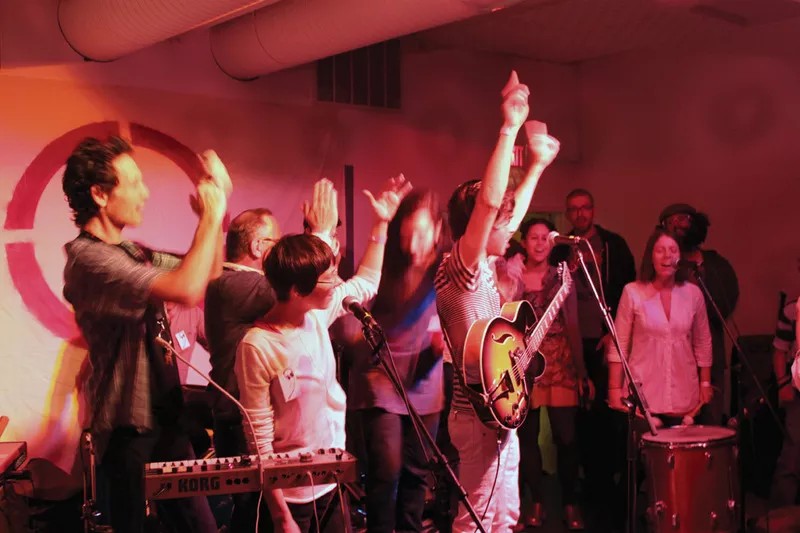
The Fine Line: Navigating Faith, Fame, and Profit in Modern Entertainment
The intersection of personal conviction and public commerce has long been a complex and fascinating subject within the landscape of Entertainment News. For artists whose work is deeply intertwined with their faith, this dynamic becomes even more pronounced. A recurring and often passionate debate centers on a fundamental question: When an artist achieves commercial success through faith-inspired content, are they “profiting from” their beliefs, or are they “profiting for” a greater purpose? This question transcends simple financial accounting; it delves into the heart of authenticity, intention, and the very nature of art as both a ministry and a business. As audiences become more discerning and artists more transparent, this conversation has moved from niche forums to mainstream headlines, impacting everything from award shows to an artist’s personal journey and Work-Life Balance.
This dialogue is not merely academic. It has real-world implications for artists navigating their careers and for fans who invest emotionally and financially in their work. It challenges us to consider where the line is drawn between a sustainable career and the potential for exploitation, between genuine expression and calculated marketing. Exploring this tension reveals much about our cultural values, the business of music, and the ongoing quest for authenticity in a world saturated with curated content. This exploration is crucial not just for those within faith-based communities but for anyone interested in the broader dynamics of Personal Development and the creator economy.
The Evolving Landscape of Faith in Mainstream Music
The journey of faith-based music from the pews to the pop charts is a story of cultural shifts, technological disruption, and evolving artistic expression. What was once a clearly defined genre, primarily confined to Christian bookstores and dedicated radio stations, has blurred its boundaries, creating both unprecedented opportunities and complex ethical dilemmas for its creators.
From Niche Genre to Crossover Phenomenon
Historically, Contemporary Christian Music (CCM) operated in a parallel industry to its secular counterpart. Artists like Amy Grant and Michael W. Smith were pioneers in the 1980s and 90s, achieving crossover success that brought their music to a wider audience. However, today’s landscape is fundamentally different. Artists like Lauren Daigle, Lecrae, and Chance the Rapper have integrated themes of faith into genres ranging from pop and hip-hop to R&B, often without being explicitly marketed as “Christian artists.” This integration reflects a broader trend in Lifestyle News, where personal values, including spirituality, are becoming more central to public identity. This shift has been amplified by streaming platforms, which prioritize mood- and genre-based playlists over traditional industry labels, allowing listeners to discover faith-inspired songs alongside secular hits.
This crossover success brings financial opportunities that can support an artist’s family, team, and philanthropic efforts. It connects to fundamental principles of Personal Finance and Financial Planning, as artists must manage newfound wealth responsibly. However, it also invites scrutiny. The central conflict arises when the machinery of the mainstream music industry—with its emphasis on branding, sales metrics, and mass appeal—is applied to content that is, at its core, sacred. The pressure to create commercially viable “hits” can clash with the call to create authentic, uncompromising art, impacting an artist’s Mental Health and creative integrity.
The Two Sides of the Coin: “For Jesus” vs. “From Jesus”
The debate can be broadly categorized into two philosophical camps. The “profiting for Jesus” perspective argues that financial success is a tool for greater impact. From this viewpoint, money generated from music can fund larger tours, support charitable causes, increase production quality, and ultimately, spread the artist’s message to a global audience. It frames commerce not as a necessary evil but as a divine provision to amplify the mission. Proponents might argue that refusing to engage with the commercial aspects of the industry is a form of poor stewardship, limiting the potential reach of a positive message. This perspective often aligns with modern approaches to Social Impact and large-scale volunteering efforts funded by successful enterprises.

Conversely, the “profiting from Jesus” argument voices a concern about commodification. This perspective fears that when faith becomes a product, its sacredness is diminished. Critics worry that artists may consciously or subconsciously tailor their message to be more palatable and marketable, sanding off the rough, challenging edges of their beliefs to appeal to the widest possible demographic. This can lead to a form of “inspirational pop” that lacks theological depth, becoming another self-help tool in the broader Health & Wellness market rather than a profound expression of faith. This view champions artistic purity and raises questions about whether the methods of the world can truly be used to advance a spiritual mission without compromise.
Anatomy of Authenticity: Case Studies in Creative Tension
To understand this debate in practice, it’s helpful to examine the different ways artists navigate this complex terrain. Their careers serve as real-world case studies in balancing artistic vision, spiritual conviction, and commercial demands. These examples provide valuable Career Advice for aspiring creators in any field where personal values are central to the work.
The Crossover Success: Blurring Lines for Broader Reach
Consider the archetype of the crossover artist whose music finds a home on both Christian and secular radio. This artist often faces the most intense scrutiny. Their lyrics might be intentionally ambiguous, allowing for multiple interpretations. A song about love and redemption could be interpreted as being about a human relationship or a divine one. While this strategy can dramatically increase an artist’s audience, it can also lead to accusations of “selling out” from their core faith-based audience. The artist must constantly manage expectations from two different worlds. This balancing act requires immense emotional resilience and can be a significant source of stress, highlighting the need for strong Stress Management practices and a focus on Sleep Health to cope with the pressures of public life.
This path requires a sophisticated understanding of branding and marketing. The artist’s team must make strategic decisions about which interviews to take, which venues to play, and how to frame the artist’s story. It’s a high-stakes game of cultural navigation where a single misstep can alienate a significant portion of their fanbase. This is where Productivity Tips and efficient team management become crucial for survival.
The Niche Purist: Prioritizing Message Over Market
On the other end of the spectrum is the artist who deliberately remains within the faith-based ecosystem. This creator prioritizes lyrical clarity and theological depth over mainstream appeal. Their primary goal is to serve a specific community, and they view their music as a direct form of ministry. While this approach provides a strong sense of purpose and a loyal, dedicated fanbase, it often comes with significant financial limitations. These artists may struggle to secure the same level of income, tour support, or industry recognition as their crossover counterparts. Their journey is often one of financial sacrifice, relying on grassroots support and a deep sense of calling. This path mirrors principles of Minimalism, focusing on essential purpose rather than external markers of success. It emphasizes a strong sense of Community Living, as the artist and their audience are often deeply interconnected.
The Genre-Bender: Redefining the Paradigm
A third archetype is emerging: the genre-bending artist who defies categorization altogether. These musicians, often in genres like hip-hop or indie rock, integrate their faith as one of many elements in their complex artistic identity. They write about doubt, struggle, and joy with raw honesty, refusing to fit neatly into either the “Christian” or “secular” box. Their approach challenges the very premise of the debate, suggesting that faith is not a category but an integral part of the human experience that should be expressed with unfiltered authenticity. This often resonates with younger audiences who are weary of polished, formulaic content. This approach to art can be a powerful tool for Self-Improvement and reflection for both the creator and the listener, touching on themes of Relationships, Family Life, and personal struggle.

Implications for the Industry and the Audience
This ongoing conversation has profound implications that extend beyond the artists themselves. It shapes the music industry’s infrastructure, influences consumer behavior, and reflects broader cultural trends in how we engage with art and spirituality.
The Industry’s Role and Responsibility
Record labels, streaming services, and award shows are key players in this dynamic. Their categorization and promotion of artists can either reinforce old boundaries or help create new, more fluid spaces. When an award show creates a “Best Contemporary Christian Music” category, it validates the genre but also risks ghettoizing it. Conversely, when a faith-based song is nominated in a mainstream category like “Song of the Year,” it signals a significant cultural acceptance. The financial incentives within the industry often dictate these decisions. A label might push an artist to soften their message to secure a lucrative brand partnership, creating a direct conflict between their Investment News and the artist’s integrity. This highlights the need for ethical frameworks and artist-centric management that prioritize long-term authenticity over short-term profit.
The Consumer’s Power and Discernment
Ultimately, the audience holds significant power. The artists and music that listeners choose to support—through streams, ticket sales, and merchandise—directly shape the market. This calls for a more mindful approach to consumption. Instead of asking a binary question of “Is this artist selling out?”, a more nuanced approach might be to ask: “Does this art feel honest? Does it challenge or comfort me in a meaningful way? Does the artist’s broader career reflect a consistent set of values?” This requires listeners to move beyond passive consumption and become active, discerning patrons of the arts. It’s a form of engagement that supports a healthier, more sustainable creative ecosystem, much like how conscious consumerism in Sustainable Fashion or Eco-Friendly Living promotes better industry practices. This mindful engagement can be a form of Holistic Health, aligning one’s entertainment choices with one’s personal values.

Best Practices and Actionable Insights
For both creators and consumers navigating this space, a set of principles and practices can help foster authenticity and sustainability. This isn’t about finding a single right answer but about embracing a more intentional approach.
For Artists and Creators:
- Define Your “Why”: Before seeking a record deal or chasing streaming numbers, clarify your core mission. Is your primary goal ministry, artistic expression, or financial success? Being honest about this from the start will guide every subsequent decision. This is a foundational aspect of Personal Development.
- Build a Community, Not Just a Fanbase: Cultivate a direct relationship with your audience through platforms that you control. A loyal community that understands your mission will support you through career shifts and protect you from industry pressures.
- Financial Transparency: Consider being open about the financial realities of your work. Explaining how income is used—to pay your band, support your family, or fund charitable projects—can build trust and demystify the “profit” conversation. This ties into responsible Budget Tips and financial stewardship.
- Seek Mentorship: Connect with veteran artists who have navigated these waters successfully. Their Career Advice and wisdom can be invaluable in avoiding common pitfalls.
For Consumers and Supporters:
- Support Directly: Whenever possible, buy music and merchandise directly from the artist’s website or at shows. This ensures a higher percentage of the revenue goes to the creator.
- Engage Beyond the Music: Read interviews, watch documentaries, and listen to what artists say about their process and intentions. A deeper context can lead to a richer appreciation of their work.
- Amplify Authenticity: Share and promote artists you believe are creating honest, impactful work, especially independent creators who may not have large marketing budgets.
- Offer Grace: Recognize that artists are complex individuals on their own journey. Allow them the space to evolve, experiment, and even make mistakes without rushing to judgment.
Conclusion: A Dialogue of Purpose and Profit
The debate over profiting “from” or “for” a higher purpose in the entertainment world is not a problem to be solved but a creative tension to be managed. There is no one-size-fits-all answer, and what constitutes authenticity for one artist may look very different for another. The collision of the sacred and the secular in the public square forces artists to confront their deepest motivations and challenges audiences to engage with art more thoughtfully. As the lines between genres and industries continue to blur, this conversation will only become more relevant. Ultimately, the most resonant art often emerges from this very friction—from the honest struggle to create something beautiful and true in a world of complex commercial pressures. The ongoing dialogue pushes the entire ecosystem—artists, industry, and audience—toward a more intentional and authentic future.
Archives
- December 2025
- November 2025
- October 2025
- September 2025
- August 2025
- October 2023
- September 2023
- August 2023
- July 2023
- June 2023
- May 2023
- April 2023
- March 2023
- February 2023
- January 2023
- December 2022
- November 2022
- October 2022
- September 2022
- August 2022
- June 2022
- May 2022
- April 2022
- March 2022
- January 2022
- December 2021
- November 2021
- October 2021
- August 2021
- November 2020
- July 2020
- May 2020
- April 2020
- March 2020
- August 2018
- July 2018
- June 2018
- April 2018
- March 2018
Categories
- Age Groups
- AI/ML
- Alternative Medicine
- Animal Health
- Animal Husbandry
- Animals
- Anti-Aging
- Architectural Design
- Auditory Science
- Augmented Reality
- Automation
- Babies
- Baby
- Beauty & Skincare
- Biohacking
- Biomechanics
- Book Reviews
- Breastfeeding
- Budgeting
- Budgeting Strategies
- Business
- Cardiovascular Health
- Career Advice
- Career Development
- Career Growth
- Cats
- Chess
- Chronobeauty
- Circular Economy
- Cleaning Tips
- Cloud Computing
- Cognitive Health
- Cognitive Performance
- Cognitive Science
- Community
- Community Building
- Community Engagement
- Community Living
- Computer Vision
- Consumer Guides
- Consumer Trends
- Container Gardening
- Content Analysis
- Content Non-Technical
- Content Strategy
- Cosmetic Chemistry
- Cultural Events
- Cycling
- Data Analysis
- Data Engineering
- Data Science
- Design Psychology
- Developer Productivity
- Diet
- Diet
- Digital Identity
- Digital Media
- Digital Wellbeing
- DIY Projects
- Dogs
- Engineering Culture
- Entertainment News
- Environmental Impact
- Environmental Science
- Equity Compensation
- Ethical AI
- Exercise
- Exercise Science
- Exercise Technique
- Exotic Pets
- Fall Gardening
- Family
- Family Health
- Family Life
- Fashion Business
- Fashion Industry
- Fashion News
- Fashion Tech
- Financial Analysis
- Financial Optimization
- Financial Planning
- Flooring Maintenance
- Food
- Food Psychology
- Food Safety
- Food Tech
- Functional Fitness
- Functional Training
- Future Of Work
- Garden Care
- Garden Maintenance
- Gardening Tips
- Greece
- Greek
- Greek Food
- Gymnastics
- Hardware Engineering
- Health
- Health And Wellness
- Health Informatics
- Health Science
- Health Tech
- Healthcare Management
- Healthy Eating
- Healthy Recipes
- Holistic Health
- Holistic Wellness
- Home & Living
- Home Decor
- Home Financing
- Home Health
- Home Improvement
- Home Organization
- Horticulture
- Identity Management
- Industrial Design
- Industry Analysis
- Infant Nutrition
- Infrastructure Management
- Ingredient Deep Dive
- Integrative Health
- Integrative Medicine
- Interior Design
- Internet of Things
- Internet of Things (IoT)
- Invalid Request
- Investment Strategies
- Investment Strategy
- IoT
- Kids
- Leadership Development
- Learning Strategies
- Lifestyle
- Lifestyle Brands
- Lifestyle News
- Lifestyle Optimization
- Literary Criticism
- Literature
- Logistics Management
- Material Science
- Materials Science
- Meal Planning
- Media Analysis
- Meditation
- Mental Health
- Mental Performance
- Mental Wellness
- Miami
- Miami Food
- Mind And Body
- Minimalism
- Mobile Development
- Neuroscience
- No Applicable Categories
- Nutrition
- Nutrition News
- Operating Systems
- Operational Resilience
- Opinion
- Organization Tips
- Outdoor Living
- Over 40
- Over 50
- Over 60
- Parenting
- Parenting
- Parenting Strategies
- Performance
- Personal Development
- Personal Finance
- Personal Growth
- Personal Productivity
- Pet Care
- Pet Safety
- Philosophy
- Politics
- Productivity
- Protein
- Psychology
- Psychology of Space
- Reading Culture
- Real Estate Investment
- Recipes
- Regulatory Compliance
- Remote Work
- Renovation Planning
- Resource Management
- Responsible Pet Ownership
- Retail Strategy
- Robotics
- Science
- Seafood
- Seasonal Gardening
- Security
- Self-Care
- Skincare Science
- Skincare Trends
- Sleep
- Sleep Health
- Smoothies
- Social Impact
- Soft Skills
- Soil Health
- Spatial Computing
- Spatial Design
- Stress Management
- Supplements
- Sustainability
- Sustainability Science
- Sustainable Engineering
- Sustainable Fashion
- Systems Engineering
- Tax Optimization
- Tax Strategy
- Tech Investment
- Travel
- Travel News
- Travel Safety
- Travel Tips
- Trend Analysis
- Uncategorized
- Urban Planning
- User Experience
- Veggie
- Virtual Events
- Volunteering
- Wealth Management
- Wearable Technology
- Wellness
- Wellness Technology
- Work-Life Balance
- Workplace Culture
- World
- Writing
- Writing Skills
- Yoga News
- Zero Waste

Leave a Reply